
A Data-Driven Journey (Part 2 of the Drake Equation Series)
In Part 1, we explored how many stars in our galaxy might have planets, and we used data to estimate the total number of stars with planets in the Milky Way. Now that we’ve tackled the stars, let’s take a closer look at the planets themselves. In Part 2, we’ll dive into how many of those planets could actually support life, how often life emerges, and how likely it is that life evolves into intelligent civilizations — like us.
As we continue through the Drake Equation, things get a bit more speculative. But don’t worry, we’ll use data science, Monte Carlo simulations, and reasonable assumptions based on current research to keep things grounded.

Quick Reminder: The Drake Equation
Just to refresh your memory, the Drake Equation breaks down the steps to estimate the number of active, communicative alien civilizations. Here’s a look at the full equation again:

Step 3: How Many Planets Are in the Habitable Zone? (n_e)
Not all planets are created equal — some are too hot, some too cold, and a few are just right. These “Goldilocks” planets sit in the habitable zone around their star, where conditions are just right for liquid water to exist. Liquid water is crucial because it’s a key ingredient for life as we know it. Planets that are too close to their star may be too hot, boiling away any water and potentially getting bombarded with harmful radiation. On the flip side, planets that are too far away are likely cold, icy worlds where liquid water can’t exist.
So, how many of these habitable-zone planets are out there?
Why We Chose This Range
Recent discoveries of exoplanet systems like TRAPPIST-1 suggest that several planets might be in the habitable zone of their star. Based on this and current research, we estimate that 1% to 20% of planets in any given system fall into this category, with an average around 10%. We chose a normal distribution for this step, assuming that habitable planets are more common in the middle of this range, but with room for uncertainty on either side.
Before we dive into the results, let’s set the stage with some SAS code to calculate this estimate.
/*Percent of Habitable Planets*/
data habitable_planets(keep=habitable_planets);
do i = 1 to 100000;
do while (1);
habitable_planets = rand("normal", 0.10, 0.025);
/* Check if the value is within the desired range */
if habitable_planets >= 0.01 and habitable_planets <= 0.2 then leave;
end;
output;
end;
drop i;
format habitable_planets percent7.4;
run;
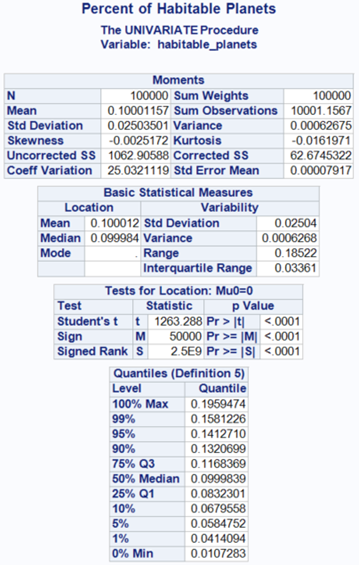
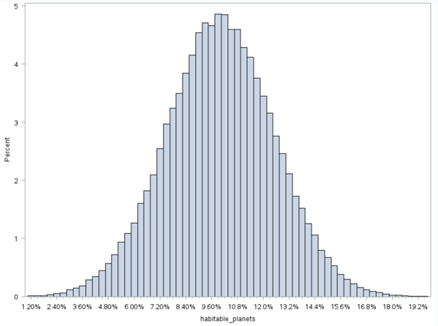
Output and Explanation for Step 3: Habitable Planets
After running the simulation, the average percentage of planets in the habitable zone came out to be 10%, with values ranging between 1% and 20%.
What Do These Results Mean?
- Balanced Estimate: The majority of the results clustered around the 10% mark, meaning that, on average, 1 out of every 10 planets could be in the habitable zone of their star.
- Room for Uncertainty: The range we chose acknowledges the possibility that some planetary systems might have none, while others could have multiple planets in the habitable zone, giving us flexibility in our estimates.
Step 4: How Often Does Life Actually Develop? (f_l)
Not all planets are created equal — some are too hot, some too cold, and a few are just right. These “Goldilocks” planets sit in the habitable zone around their star, where conditions are perfect for liquid water to exist. Liquid water is crucial because, as far as we know, it’s a key ingredient for life. However, we have to acknowledge that our sample size for life-bearing environments is extremely small — in fact, it’s just one: Earth.
Our understanding of the conditions needed for life is entirely based on carbon-based life forms like the ones we find here. Planets that are too close to their star may be too hot, evaporating away any potential water and suffering from high levels of radiation. On the other hand, planets too far from their star are likely cold, icy worlds where liquid water can’t survive. While we know life thrives in a narrow range of conditions here on Earth, this is guesswork beyond our planet.
For this analysis, we’re focusing only on the kind of life we know — carbon-based organisms that need water, not more exotic ideas like silicon-based life forms or inter-dimensional beings.
Why We Chose This Range
We estimate that life develops on 1% to 25% of habitable planets, with an average around 17%. To reflect the possibility that life might have a higher chance of appearing when the conditions are just right, we use a left-skewed distribution. This means that while life may not always appear, when it does, it has a good shot of thriving.
Let’s jump into the code and see what the simulation tells us.
/*Percent of Habitable Planets where Life Develops*/
data perc_life_develop;
mean_pct = 0.15; /* Mean percentage */
skewness = -6; /* Control the left skewness */
sigma = (log((1 + (skewness ** 2)) ** 0.5)) / skewness; /* Calculate sigma for Lognormal distribution */
/* Generate random values from a left-skewed Lognormal distribution */
do i = 1 to 100000;
u = rand("uniform"); /* Uniform random variable */
perc_life_develop = 0.001 + (0.25 - 0.001) * exp(sigma * rand("lognormal", 0, 1));
output;
end;
format perc_life_develop percent7.4;
run;
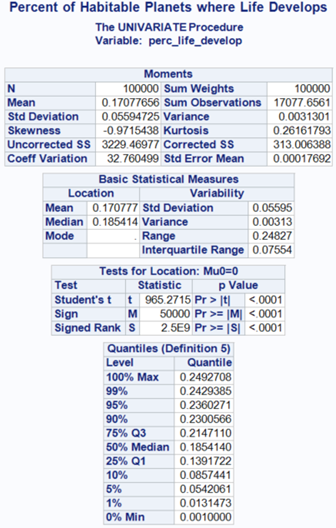
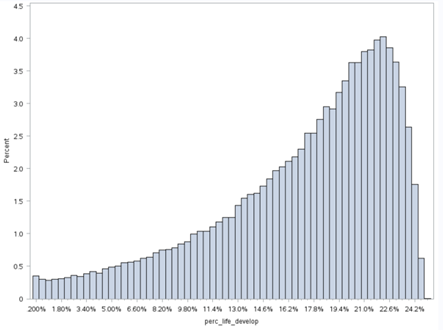
Output and Explanation for Step 4: Life-Developing Planets
After running our simulation, we found that the average percentage of habitable planets where life develops is 17.08%, with values spread between 1% and 25%. Let’s break down what this means for our overall analysis.
Breaking Down the Results
- “Life Finds a Way”: As Spielberg’s famous quote suggests, our simulation reflects that, when conditions are favorable, life is likely to emerge. With an average of 17.08%, this suggests that nearly 1 in 6 habitable planets could develop life. This is an optimistic outcome, given that the appearance of life requires a multitude of factors aligning perfectly.
- Distribution Shape and Skewness: The histogram shows a left-skewed distribution. This skewness indicates that while most planets in the simulation had a relatively low probability of developing life, many clustered toward the higher end of the scale, near 20–24%. The positive skew shows us that, when favorable conditions are present, life tends to have a better chance of emerging. In other words, once the right ingredients are there, life finds a way more often than not.
- Quantiles and Range: The interquartile range (from 13.97% to 21.47%) shows that, in most simulations, the probability of life developing falls within this mid-to-high range. The 95th percentile comes in at 24.24%, which tells us that while the possibility of life is somewhat uncertain, the model predicts life will emerge on a considerable number of habitable planets, given the right conditions.
Why These Results Matter
This is a critical step in the Drake Equation because it sets the tone for how many potential “life-bearing” planets exist. If a significant fraction of habitable planets develop life, then our chances of finding extraterrestrial life rise accordingly.
The higher concentration of probabilities at the upper end of the range suggests that, once conditions are suitable, life is likely to develop. This insight is vital for the subsequent steps because we need life before we can even talk about intelligence or communication technologies.
However, the slight uncertainty at the lower end of the range (1–5%) reminds us that life may not always emerge, even when conditions seem right. This adds nuance to the discussion — some planets may have all the right ingredients but still remain barren.
Impact on the Drake Equation
What does this mean for our broader analysis?
- Life is more likely than not: Given the results, it seems reasonable to assume that life will develop on a good portion of habitable planets. This feeds into our overall estimate of how many planets could eventually host intelligent civilizations.
- Setting the stage for intelligence: Now that we know life is likely to emerge on about 17% of habitable planets, we can move on to the next big question: how often does that life evolve into something intelligent, capable of building technology and civilizations?
Step 5: How Often Does Intelligent Life Emerge? (f_i)
Now for the big one — how many of these life-bearing planets evolve intelligent civilizations like ours? This is one of the most speculative steps in the Drake Equation. The evolution of intelligence requires overcoming some major hurdles, or “hard steps,” in the path from simple life to advanced beings.
We estimate that intelligent life develops on 0.01% to 1% of life-bearing planets, with an average of 0.13%. In other words, even though life might pop up fairly often, intelligence is a long shot.
Here are some of the major hard steps that life must overcome to become intelligent, and why they make this step of the equation so rare:
- The Leap from Simple Cells (Prokaryotes) to Complex Cells (Eukaryotes):
This is where life goes from “just surviving” to evolving into something more complex. The development of complex cells, like the ones humans have, is a monumental step that requires specific conditions, which is why it’s so rare. - The Evolution of Multicellular Life:
It’s one thing to be a single-celled organism, but forming complex, multicellular organisms is a whole different ballgame. Multicellularity opens the door to specialized cells (like brain cells), but getting there takes millions, if not billions, of years. - The Development of Complex Brains:
Intelligence requires a brain capable of higher-order thinking. This isn’t just about surviving but about problem-solving, communication, and developing tools — leaps that only a few species on Earth have managed. The evolution of advanced brain structures is a monumental challenge. - Overcoming Extinction Events:
Life on Earth has faced a series of extinction-level events, like asteroid impacts and volcanic eruptions. The fact that intelligent life survived and continued evolving is nothing short of miraculous. These events wipe out huge numbers of species, so surviving them is critical for any chance of evolving intelligence. - Social and Technological Evolution:
Even if a species develops intelligence, it must then evolve social structures and technologies that allow for survival and growth. Species need to work together, communicate, and invent technologies that shape their environments. This final step is where civilizations begin to emerge.
Each of these “hard steps” introduces a new challenge, making it less likely that life will develop into something intelligent and capable of building a civilization. And that’s why we assume intelligent life is so rare. Now, let’s see what the simulation has to say.
Why We Chose This Range
We estimate that intelligent life develops on 0.01% to 1% of life-bearing planets, with an average around 0.13%. We use a normal distribution skewed toward the lower end because intelligent life is rare. It takes a series of evolutionary leaps to make the transition from simple life forms to intelligent beings capable of building advanced civilizations.
Here’s the code to calculate this step.
/*Percent of Planets where Intelligent Life Develops*/
data perc_intelligent(keep=perc_intelligent);
do i = 1 to 100000;
do while (1);
perc_intelligent = rand("normal", 0.001, 0.001);
/* Check if the value is within the desired range */
if perc_intelligent >= 0.0001 and perc_intelligent <= 0.01 then leave;
end;
output;
end;
drop i;
format perc_intelligent percent7.4;
run;
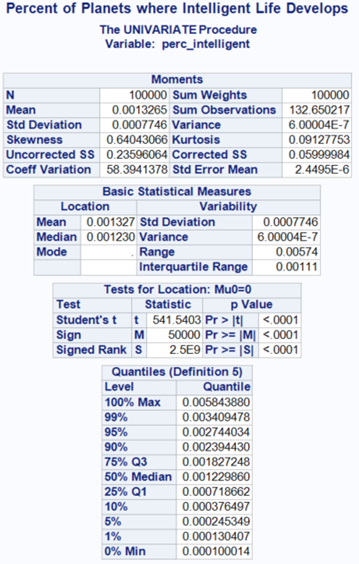
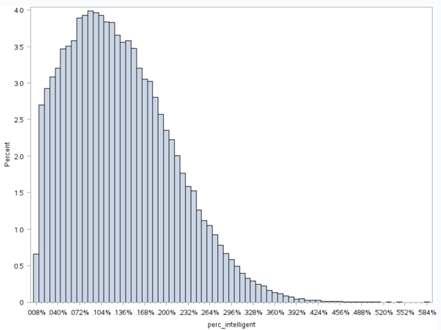
Output and Explanation for Step 5: Intelligent Life-Developing Planets
After running our simulation, we found that the average percentage of planets where intelligent life emerges is around 0.13%, with values ranging between 0.01% and 1%. At first glance, this might seem like an extremely small figure — but when we consider the complexities involved, it makes a lot of sense.
Rare, But Within Reach
The results reinforce a widely held belief: the emergence of intelligent life is rare. The majority of simulations clustered toward the lower end of the spectrum, with 75% of simulations predicting that intelligent life develops on fewer than 0.18% of life-bearing planets. This means the emergence of intelligent civilizations is not a frequent event. However, it’s important to note that the distribution has a slight skew toward the higher end, meaning there are occasional instances where intelligent life might appear more frequently on certain planets. It’s rare, but not impossible.
The Complex Path to Intelligence
When we consider the evolutionary steps necessary for a planet to go from simple life forms to intelligent beings capable of developing advanced technology, it’s easy to understand why this figure is low. There are numerous evolutionary hurdles — what we’ve referred to as “hard steps” — that life must overcome. From the development of complex multicellular organisms to the emergence of advanced brains and cognitive abilities, each of these steps represents a critical, often unlikely, leap forward.
In this context, the rarity of intelligent life doesn’t seem surprising. It takes not only the right conditions for life but also a long, unpredictable path of evolution to result in intelligence.
Narrowing the Field
Let’s take stock of where we are in the Drake Equation. In Step 4, we estimated that around 17% of planets in the habitable zone might develop life. Now, with only 0.13% of those life-bearing planets potentially evolving into intelligent civilizations, we’ve dramatically reduced the pool of possible candidates for intelligent extraterrestrial life. While these figures may seem small, remember that we’re dealing with an astronomical number of stars and planets. Even a tiny fraction of a vast number still leaves room for the possibility of intelligent civilizations.
What This Means for the Drake Equation
This step represents a critical narrowing of our search. While we’ve already seen that planets in the habitable zone with life could be relatively common, the development of intelligent life is far less so. That said, even with these low odds, the sheer size of the galaxy means that we could still be looking at a number of intelligent civilizations, albeit a much smaller group than we started with.
What’s Next?
In this analysis, we’ve narrowed our focus even further, identifying how rare intelligent life is in the vastness of space. But the search isn’t over yet. In Part 3, we’ll explore whether those intelligent civilizations develop the technology to communicate across the galaxy. So, while we now know that intelligent life is a long shot, the question remains: are they trying to talk to us?
Next in the series: Communicating with the Cosmos: Estimating Alien Civilizations (Part 3 of the Drake Equation Series). Or, if you missed the previous part, go back here.
Unless otherwise noted, all images are by the author
From Stars to Life was originally published in Towards Data Science on Medium, where people are continuing the conversation by highlighting and responding to this story.
Originally appeared here:
From Stars to Life
